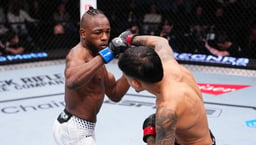
Issue 135
December 2015
All digits are against the rules if you’re grabbing the cage walls during a fight
Marc Goddard
FO’s leading international referee begins a new series analyzing MMA’s Unified Rules
The Unified Rules of Mixed Martial Arts are the definitive regulations for MMA in the United States, and are used by many by other promotions and jurisdictions around the world. But do you know how they were derived and constructed? And more importantly, do you know what the actual definition of each rule is, and how it should be applied?
MMA as we now know it today originated from many fighting styles and Vale Tudo events – full-contact unarmed combat that became popular in Brazil in the 20th century. As the sport evolved and gained recognition and momentum a number of state regulatory bodies, namely the California State Athletic Commission (CSAC) and New Jersey State Athletic Control Board (NJSACB), realized the need for a single, common rule set that no longer differed from state to state.
In 2001, the rules (originally created by the CSAC) were firstly adopted by the NJSACB and then quickly rolled out, recognized and adopted by the Association of Boxing Commissions (ABC) to other states, territories and countries throughout the world. The rest, as they say, is history.
Referees take a lot of flak for some of the decisions we make during fights around the world, but often fans and critics don’t fully understand the exact reasons why we do what we do. So, I’d like to offer you a deeper guide to the rules of MMA to take away for the next time you watch a fight.
We’ll kick the new Unified Rules series off with one of the sport’s most frequent infringements, but one that isn’t fully understood by fans and even some fighters too.
Rule break
Holding onto or grabbing the fence.
In action
A fighter may place the flat of their hands and feet against the cage. They can use the cage to push off and change direction, but once the toes or fingers grip the fence material to control, alter or change the direction or movement of a fight then it’s classed as a foul and the referee has to take action.
Breakdown
Not a lot of people are aware that the toes are classed and treated exactly the same way as fingers. Refs have to look for the actual affect on the outcome of a fight – by controlling or changing direction, reversing or helping to maintain a position. It’s at this juncture when we must act.
Many times a falling fighter will instinctively reach out to grab the cage because being taken down results in a falling motion. Try it for yourself. It can simply be an involuntary reflex. We can, and often do, warn athletes not to do this without interrupting the course of the fight. After all, who wants a trigger-happy ref spoiling the action for every single act regardless of significance?
But if the foul is repeated, or the grab resulted in a detrimentally significant change in the course of the contest, then we have the authority to deduct points if necessary. On top of this, fighters who gain an advantageous position as a result of the foul should have the position removed, a warning and/or point deduction issued if it’s warranted. When the action is restarted, the fight should begin again in a neutral position.
Cage catchers
Fouling four
Since the Unified Rules were introduced, only four points have been deducted for fence grabs during UFC fights that went to the judges scorecards.
...









